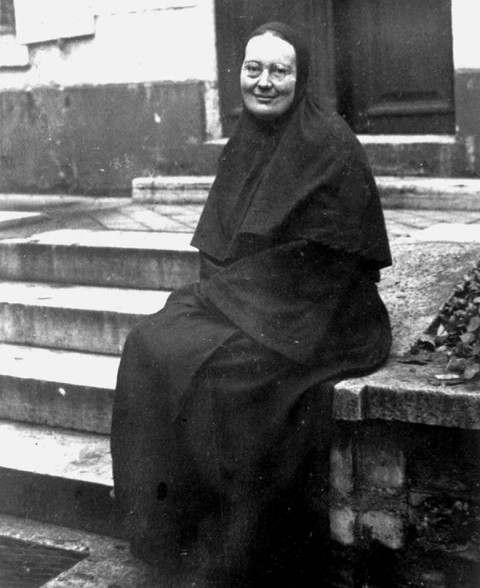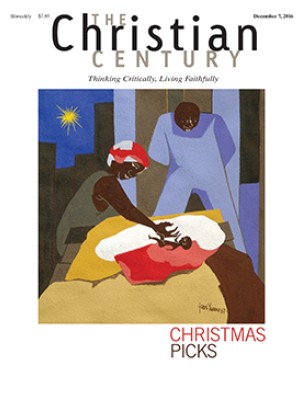What we can learn from an Orthodox nun
She died resisting the Nazis. Her critique of Christians in society still resonates today.

In the midst of Nazi-occupied Paris, an independent-minded Russian Orthodox nun lamented that Christians were not equipped to meet the challenges of the moment. “I look everywhere and nowhere do I find anything that would point to the possibility of a breakthrough from material life to eternity,” wrote Maria Skobtsova in an essay titled “Insight in Wartime.” She did not see around her any forms of Christian life that had the “right voice, the right pathos, the kind of wings” to stand against the terrors of the era.
Skobtsova herself was perhaps the exception. Born in 1891 under the czar, she had by the 1940s been a Bolshevik, a poet, and a refugee. She was almost killed by both White and Red armies during the Russian Revolution of 1917. She fled Russia after briefly serving as the deputy mayor of Anapa, a city near the Black Sea. In exile she returned to the Orthodox faith, and in 1932 she became a nun.
Read our latest issue or browse back issues.
She refused, however, to take up residence in a convent or traditional religious community. Issuing a thoroughgoing critique of monasticism, she insisted that she would seek instead “to share the life of paupers and tramps.”
In Paris, she set up hospitality houses for the poorest of the poor that somewhat resemble the Catholic Worker houses established by Dorothy Day in the United States. Skobtsova’s houses offered food and shelter for those in need and served as gathering places for Russian émigrés, which included thinkers such as Nikolai Berdyaev and Sergei Bulgakov. During the Nazi occupation, these houses also offered refuge to Jews, providing them with false baptismal certificates to help them avoid arrest and helping them flee to the south of France.
It was a request for a baptismal certificate that led eventually to Skobtsvoa’s death. In 1943, the Gestapo raided one of the hospitality houses and found in her son’s pocket a letter from a Jewish family requesting aid. Skobtsova, along with her son and her close friend, Father Dimitri Klepinin, were arrested. She was sent to Ravensbrück concentration camp, where she died in a gas chamber in 1945. Survivors of Ravensbrück report that in the camp she organized discussion groups that “provided an escape from the hell in which we lived.” The groups discussed biblical passages, told stories, and rekindled “the flame of thought, which barely flickered beneath the heavy burden of horror.”
Skobtsova, who was canonized a saint in the Orthodox Church, left behind a variety of writings, some of which have been collected in Mother Maria Skobtsova: Essential Writings (Orbis). One of these works is the essay “Religious Types” in which she identifies and rejects four ways of being a Christian before articulating her vision of the authentic path.
Though her types draw on Russian Orthodox tradition and practice and are not immediately applicable to the American Christian context, they offer modern Christians an opportunity to reflect on the position of Christianity in our time and to ask, with Skobtsova, if we are prepared to meet the particular challenges in front of us.
Skobtsova’s first type was the synodal Christian. This type of Christian had been seared by the triumph of communism in Russia and looked back fondly to the era of Peter the Great, who sought to bring the Russian Empire and Orthodox Christianity close together. Synodal Christians brought with them to exile in Paris a strong sense of nationalism that was deeply rooted in faith. They brought not only their regimental banners from the fight with the Bolsheviks, but also their churches, their iconostases, and liturgical vessels. They wanted, in some way, to keep alive a Russia that had been lost in revolution and war. The church was, for these refugees, a national symbol.
Before World War I, the state had appointed church hierarchs and managed the church’s activities. Spiritual life took a backseat to administrative life. The result, Skobtsova said, was that piety was a state virtue, “necessary only because the state had need of pious people.” But such piety had become rote, which made it easy for the Bolsheviks to exploit people’s latent religious fervor. The Bolsheviks attracted those with “the flaming passion of a true religious life.”
The synodal system was conservative: all of its energies went into preserving tradition. Creativity was discouraged and change impossible. Likewise impossible, Skobtsova argued, was any possibility of following Christ.
Skobtsova predicted extinction for the synodal type. Having been driven into exile, synodal Christians would be able to keep up their traditions only for a short time. She couldn’t have imagined the fall of the Soviet Union, Vladimir Putin’s alliance with Patriarch Kiril, and the day when synodal Christians would be invited back to Russia to reinvent the union between the Russian church and the Russian state—but she was well aware of the dangers of aligning nationalism with religion.
The second type that Skobtsova described was the ritualistic Christian. Skobtsova pointed to the schism in Russian between the Old Believers and the state church over the proper way to cross oneself, or how to write the name of Jesus. For ritualistic Christians, the focus on ritual behavior took priority over other forms of goodness. People were willing to fight and to die for gestures. Skobtsova had particularly harsh words for this form of faith: “Moscow reforged all . . . the vibrancy of the Byzantine genius into an immovable form, a cult of the letter, a repetitious, rhythmical gesture . . . ossifying it and depriving it of its grace-filled, living spirit.”
She believed this type of Christianity was alive and well in her own day. The desire to “replace spirit with form, love with ritual” was apparent among Russian exiles. Underlying the desire for ritual, she argued, was a desire for control. The condition of exile encouraged this kind of Christianity because ritual was one thing that exiles could determine. But she saw behind the desire for control “a thirst for authoritarian leaders who can lead a blind and loyal mass behind them.” In Nazi-occupied Paris, the desire for “spiritual hygiene” led directly to the abandonment of one’s neighbors to the police.
Skobtsova’s third type was the aesthete. The identity of the aesthetic Christian had deep roots in Orthodoxy. The founding legend of the Russian Orthodox Church tells of St. Vladimir’s visit to Constantinople and his return to Russia, where he reported having compared the world’s religions and deciding that Byzantine Christianity was by far the most beautiful. He therefore insisted that the Kievan Rus’ state would be Orthodox. It was not the theological content of the religion that moved him, but the beauty of the churches, the singing, and the icons. Rhapsodies about the beauty of Orthodoxy have been an important part of Russian spirituality ever since.
Skobtsova’s objections to aesthetic Christianity were threefold. One was its fundamental elitism. “Beauty and appreciation of beauty,” she wrote, “are always the province of a small minority.” She made this argument even though she herself was both an artist and a poet. Her communal houses were places where art, including her own elaborate embroideries, could be displayed. But the way that the aesthetic Christian used beauty bothered her. Anyone who was “too simple or too unrefined” was excluded from the circle, and eventually, aesthetic criteria crowded out spiritual criteria. Certain hymns were seen as having artistic merit, others not. Worshipers become either props for proper worship or “tedious and annoying barbarians, who by their ignorance, clumsiness, and, occasionally, by their personal sorrows and special needs, encroach upon the grandeur and orderliness of the service.”
This kind of spirituality brings “ice” to the soul, she wrote. Despite the aesthetes’ appreciation of beauty, Skobtsova believed they were too locked into their own perspectives to be truly creative. True creativity is messy and even destructive. “The psychology of the museum curator is incompatible with that of the creative individual,” she wrote. The church had to reach the simplest people. It had to be radically open to new expression. The aesthete will not notice, she wrote, when Christ quietly slips out of the perfectly splendid sanctuary with its perfectly modulated singing and goes out on the steps to sit with those who have been “deformed by sin, by ugliness, drunkenness, depravity, and hate.”
Her third objection to aesthetes was that they divide up the world into good and bad, beautiful and ugly, the acceptable and unacceptable. “When defending aesthetic values, the aesthete divides the whole world into friends who understand and appreciate his values, and enemies, the profane crowd.” Skobtsova pinpoints the way that Christianity can be used to divide up the world into the worthy and unworthy.
The fourth type might have been closest to Skobtsova’s own worldview. Yet it is the one that she criticized most harshly: the ascetic Christian. She recognized the centrality of asceticism in religion as a whole and argued that eras when asceticism is absent are marked by “decline and decay.” Religious life demands sacrifice, and so it always has a form of asceticism within it.
She identified several kinds of asceticism. One demands mastery of the body and spirit in order to produce spiritual power. People do spiritual exercises the way that body builders build muscles or singers sing scales to increase their vocal range. Ascetics fast, deprive themselves of sleep, order their lives, meditate at length in order to maximize “those forces with which they have been endowed by nature.” She called this a “spiritual naturalism” and argued that, while it is a part of Christianity, it is at odds with the self-surrendering asceticism of Christianity.
She was especially critical of a form of asceticism that sought the salvation of the individual soul above all else. This kind of asceticism strives toward obedience and becomes obsessed with a soul’s standing before God. What troubled her about this particular path is that love becomes subservient to salvation. The ascetic “knows that, as the Apostle said, love is the greatest thing of all, and that for the salvation of the soul in addition to any other virtues there must be love. . . . He will teach himself, he will force himself to love.” But what arises instead is a “certain coldness, an extraordinary spiritual stinginess, a kind of miserliness.” Another human being, whom one is being asked to love, is regarded as a means for benefiting one’s own soul. This kind of asceticism is “an extreme form of egoism, an improper and inadmissible act of self-preservation.”
All of the types that Skobtsova identified fail in one crucial way: they fail to follow the commandment to love your neighbor as yourself. For Skobtsova, the second commandment was identical with the first commandment, “two aspects of a single truth.” Each of the types represented a failure to love. Each also represented a failure of the creativity that the present moment demanded.
The one type that Skobtsova thought might succeed where all of the others failed was one she called “evangelical.” By this term she did not mean Protestantism, which she thought had a “distorted and impoverished doctrine of salvation.” By evangelical, she meant a “Christification” of all of life. A person on the path of love will give absolutely everything away, including her inner life.
Skobtsova often uses the phrase “poor in spirit.” A person who is poor in spirit does not hoard spiritual treasures any more than material ones. She knows the “strange law of the spiritual life,” in which “everything that is not distributed, everything that is saved, everything that is not lovingly given away somehow degenerates, becomes corrupt, is consumed in flames.”
Skobtsova was deeply influenced by the concept of sobornost, which 19th-century Slavophiles had defined as “spiritual community of many jointly living people.” The term emerged out of the effort to articulate the virtues of Russian civilization in contrast to Western individualism. Sobornost, she argued, was paradoxically the most intimate part of an Orthodox person’s life. “What is most personal . . . is thoroughly pervaded by this sense of being united with everyone.” Sobornost was both an inward path and an outward endeavor. The Christian worked to bring the unity of both commandments together in her own inner life and in her outer work using sobornost as a guide.
Skobtsova’s pursuit of this spiritual poverty and spiritual community often frustrated and annoyed her fellow workers. In his biography of Skobtsova, Pearl of Great Price, Sergei Hackel describes how she would leave mass to sort groceries or to answer the door and hold a long conversation. She allowed herself no private space and slept next to the coal stove in order to make more room for others, but she would also host late-night discussions and parties, to the frustration of others in the house. She was extreme in her statements—“either Christianity is fire or there is no such thing”—and her sharp judgments often led her companions to make their own judgments on her life and choices. But she believed—and lived—that every human encounter was an opportunity for communion with God. In each human encounter, one has the opportunity to taste the blessedness of God’s kingdom, and that happens “whenever in love we do not seek our own ends.”
Reflecting on our own moment and the forms of Christianity in our time, it is not hard to see the relevance of her critique. It is not hard to see evidence of an unhappy link between an American empire and the church. We can also see cases where ritual is emphasized to the detriment of love. We can see how the gospel is used to separate ourselves from others, to divide people into opposing camps, and to avoid those who have been “deformed by . . . hate.” We may prefer that church life look a certain way rather than delve into the messiness and risk of love and creativity.
Are we more image-conscious than love-conscious? Do we prefer tradition to people? Do we sometimes have an athletic orientation to our faith, attempting to reach great heights in spiritual exercises at the expense of other people? Do we hoard both our material and our spiritual wealth?
In raising these questions, Skobtsova’s life and writings challenge our own lives. They prompt us to ask: Do we have the “right voice, the right pathos, the kind of wings” to meet our own moment?
A version of this article appears in the December 7 print edition under the title “True evangelical faith.”







